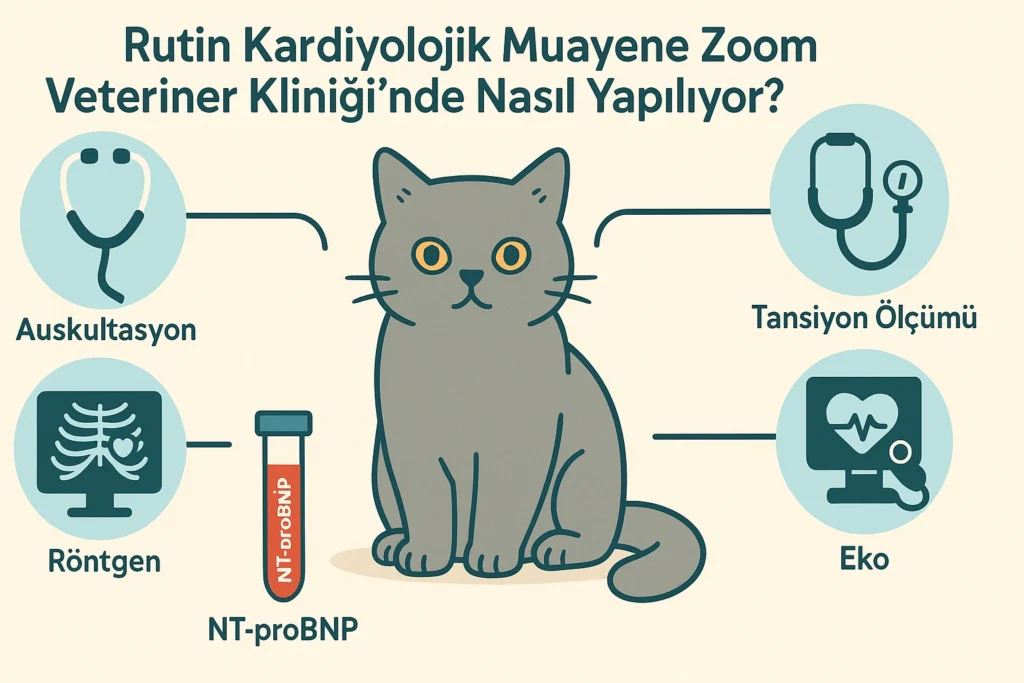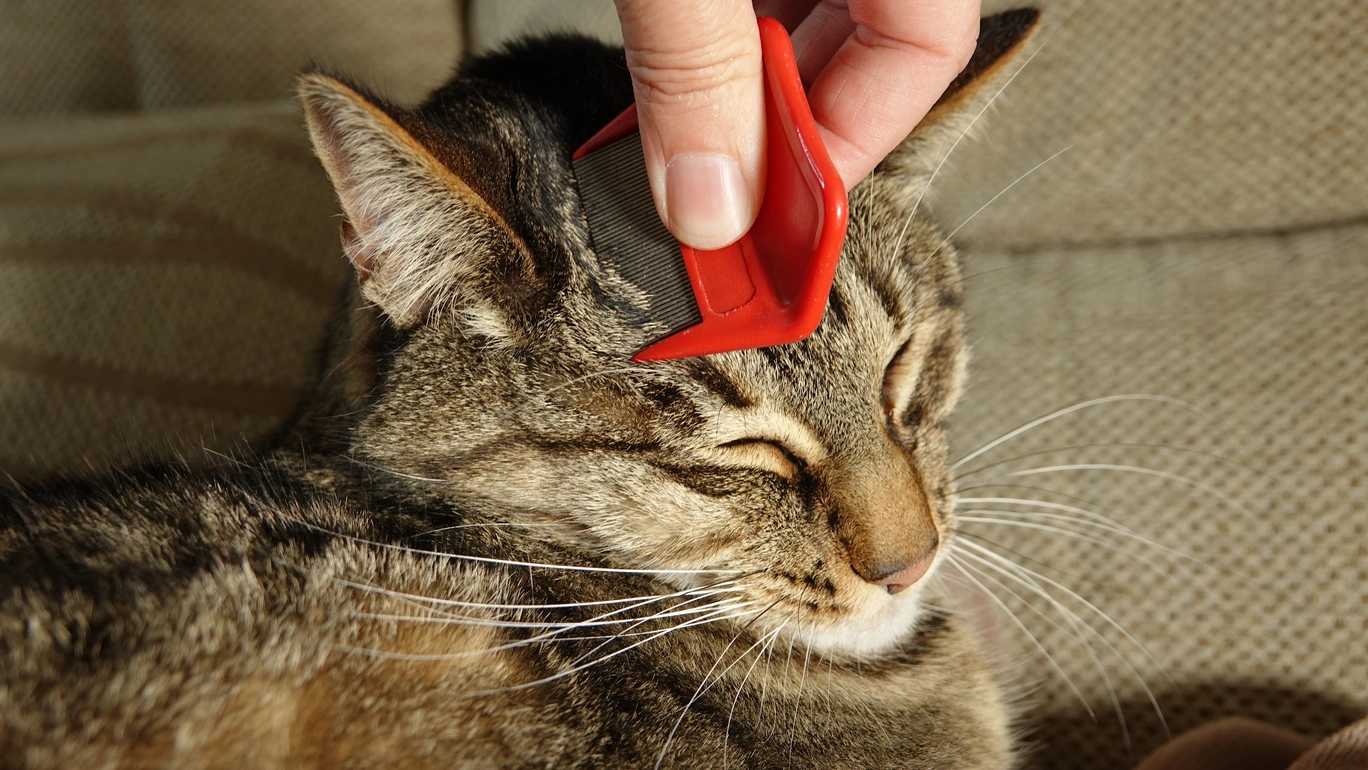British Shorthair Heart Screening: The Most Reliable Way to Protect Your Cat’s Heart
British Shorthair heart screening is the most definitive way to detect hypertrophic cardiomyopathy (HCM)—which is common in this noble breed—before any signs appear. With regular echocardiography and NT‑proBNP screening, you can protect your British friend’s heart while significantly reducing the risk of sudden paralysis and sudden death.
1. Prevalence of Heart Disease in the British Shorthair Breed
When we say British Shorthair heart screening, the first risk that comes to mind is hypertrophic cardiomyopathy (HCM), statistically more common in this breed. Field studies show that British Shorthairs have an HCM prevalence 2–3 times higher than the general cat population. For example, in a Danish screening of 329 British Shorthairs, 8.5% had definitive HCM and 4.3% had suspicious findings; the rate rose to 20.4% in males.
Two main factors lie behind these high rates:
-
Genetically Narrow Pool – Closed pedigrees are used to preserve popular color variants, keeping heart‑disease‑prone genes in circulation.
-
Delayed Symptoms – Because British Shorthairs are laid‑back, early warning signs like shortness of breath, lethargy, or poor appetite are often mistaken for a “lazy character” and overlooked.
The result? A seemingly healthy British Shorthair under 4 years old can develop thromboembolic paralysis or acute heart failure within a few months. That’s exactly why routine cardiology examinations in British Shorthairs are recommended at least once a year.

2. What Is Hypertrophic Cardiomyopathy (HCM)?
Hypertrophic cardiomyopathy (HCM) is the most common primary cardiomyopathy in cats, in which the heart muscle walls (especially the left ventricle) thicken abnormally due to genetic or idiopathic causes. The thickened muscle impairs both relaxation (diastole) and the heart’s ability to pump blood to the body (systole). It’s called the “silent killer” because the disease can progress for years without any symptoms.
4 Critical Consequences of HCM
-
Left‑Sided Heart Failure – Fluid accumulation in the lungs (pulmonary edema) → rapid breathing, cough.
-
Left Atrial Enlargement – Blood stasis → aortic thromboembolism; often presents as hind‑leg paralysis.
-
Obstruction (SAM) – Thickened septum narrows the outflow tract → murmur and syncope.
-
Ventricular Arrhythmias – Electrical instability → sudden cardiac arrest.
Why Is It More Dangerous in British Shorthairs?
-
Breed‑Specific Mutations: Variants detected in the MYBPC3 gene may accelerate disease course.
-
Low Symptom Threshold: Their broad body build can mask breathing difficulties until the disease is advanced.
This picture proves that the concept of British Shorthair heart screening is not only about treatment but also an early diagnosis and preventive strategy. When echocardiography, color Doppler, and NT‑proBNP are used together, more than 80% of subclinical HCM cases can be caught at the first screening. Whether or not a murmur is heard in your cat, having this screening once a year lets you sleep soundly for life.
Remember: HCM is mostly hereditary in British Shorthairs, so early diagnosis protects not only your current cat but also planned litters.
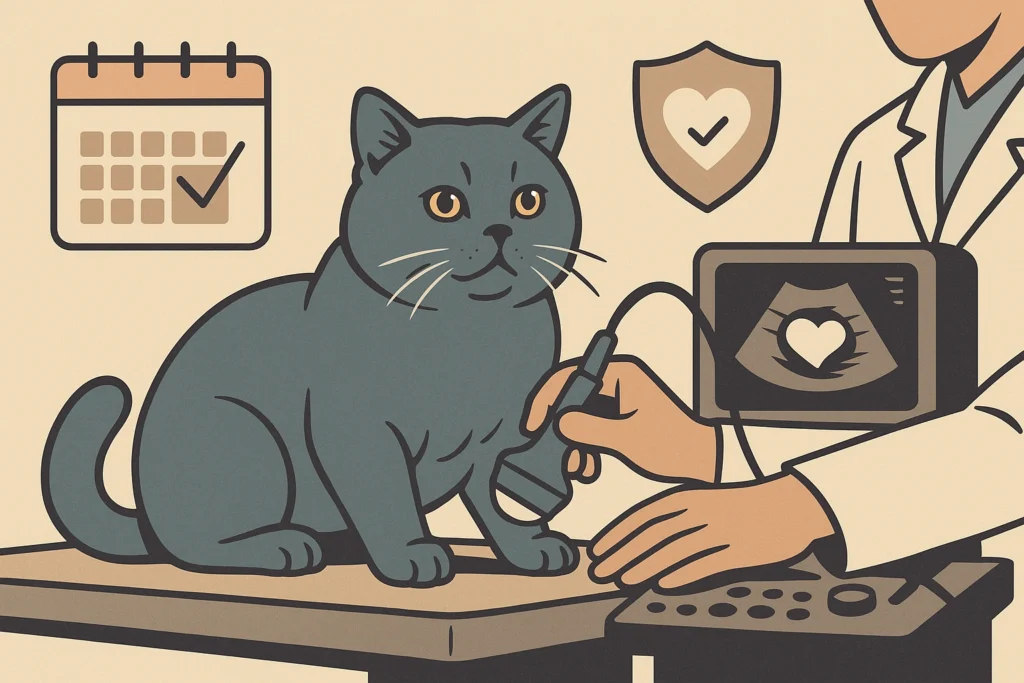
British Shorthair Heart Screening
3. Why Routine Cardiology Screening?
British Shorthair heart screening is the only reliable way to detect HCM early, even if your cat appears asymptomatic. Each item below protects both your cat’s long‑term health and your budget:
| Reason | Benefit for Your British Shorthair |
|---|---|
| Early Diagnosis | Catches silent HCM before signs appear; reduces risk of sudden paralysis and sudden death by up to 70%. |
| Longer Lifespan | With appropriate treatment and follow‑up, the likelihood of heart failure and thromboembolism drops, and average life expectancy extends by 2–3 years. |
| Genetic Counseling | Eliminates affected or carrier animals from breeding, improving long‑term breed health. |
| Medication & Diet Planning | Interventions such as antithrombotic therapy, beta‑blockers, and L‑carnitine supplementation are started at the right time and dose. |
| Exercise & Stress Management | A strategy is created to avoid triggers such as excessive exertion, heat stroke, and fear responses. |
| Preventive Care | Regular check‑ups reduce the rate of emergencies requiring intensive care by an average of 60%. |
Summary: A once‑a‑year screening keeps your cat purring with healthy heartbeats for life and saves you from unexpected expenses.
4. How Is Routine Cardiology Screening Performed at Zoom Veterinary Clinic?
Location: Erenköy, Kadıköy – the central cat‑friendly clinic on Istanbul’s Anatolian side.
-
Welcome & Cat‑Friendly Waiting Area
-
Dog‑free area, pheromone diffuser, and non‑slip flooring; stress hormones 40% lower.
-
-
Auscultation & Pulse Assessment
-
Murmur classified by grade III–VI scale and femoral–radial pulse synchronization test.
-
-
Non‑Invasive Blood Pressure Measurement
-
Oscillometric + Doppler combination; if hypertension is mimicking wall thickening, it is detected early.
-
-
Advanced Echocardiography
-
High‑resolution probe; left atrial diameter, wall thickness, and SAM angle measured in the same session.
-
-
Color Doppler Flow Analysis
-
LVOT flow velocity, regurgitant volume, and turbulent flow are mapped; obstruction severity is quantified.
-
-
NT‑proBNP or Troponin I Rapid Test
-
Two drops of capillary blood; shows subclinical myocardial stress, results in 10 minutes.
-
-
Digital X‑ray & ECG
-
Additional imaging is performed if pulmonary edema is suspected or an arrhythmia is detected.
-
-
Personalized Report & Treatment Plan Within 24 Hours
-
Beta‑blocker doses, diet recommendations, and the next British Shorthair heart screening appointment are scheduled.
-
Every step is performed without sedation. The total session lasts about one hour, and your cat returns home without stress.
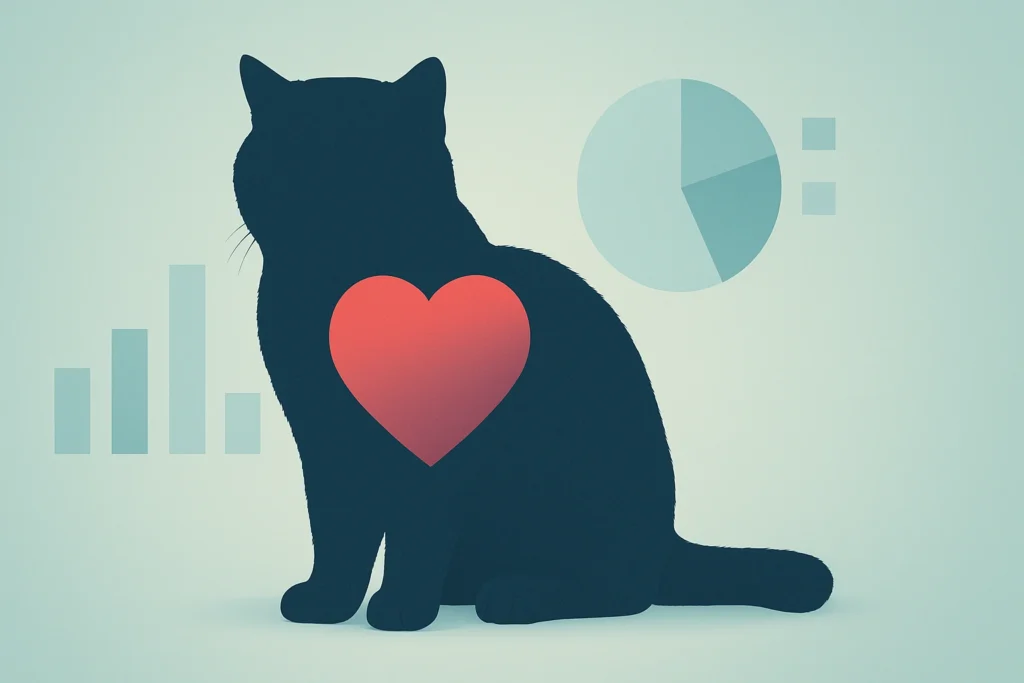
British Shorthair Heart Screening
5. Screening Frequency and Suggested Age Schedule
| Age / Condition | Recommendation | Scientific Rationale | Practical Tip | |||
|---|---|---|---|---|---|---|
| < 1 Year | A baseline heart screen during the kitten wellness check | 70% of congenital defects (VSD, PDA) are detected in the first 6 months. | If added to the vaccination visit, no sedation is needed. | |||
| 1 – 3 Years | Annual echocardiogram + NT‑proBNP | The most common window for preclinical HCM to appear. | Weigh food; weight gain can mask wall thickening. | |||
| 4 – 7 Years | Once a year; progression may accelerate | LV wall can thicken ≈ 0.3 mm per year; early intervention slows ventricular distortion. | Having screening at the same clinic increases measurement consistency. | |||
| > 7 Years | or Breeding Cat | Twice a year + blood pressure | Diastolic failure often progresses alongside hypertension. | If you can’t do BP at home, use the cat‑friendly room at the clinic. | ||
| Clinical Signs (murmur, syncope) |
Repeat in 3–6 months | SAM angles in obstructive HCM vary; close follow‑up is needed. | Block indoor stairs and limit sudden exertion. |
5.1 Why Different Frequencies by Age and Status?
-
Metabolic Rate: Cell turnover is faster in young cats; thickening is linked to kinase activity.
-
Hormonal Changes: Especially in intact males, high testosterone can trigger myocardial hypertrophy.
-
Breeding Stress: In breeding queens, hemodynamic load increases post‑pregnancy; echocardiography is recommended 4–6 weeks postpartum.
5.2 How to Schedule a British Shorthair Heart Screening?
-
By appointment cardiology screening – To minimize stress, we recommend coming by appointment.
-
12‑Hour Feeding Log – To rule out hypoglycemia episodes seen in HCM.
-
Pheromone‑Scented Towels in Carrier – Lowers stress cortisol by 30% and yields more realistic BP readings.
-
Blood Pressure First, Then Echo – Prevents “white‑coat hypertension” errors.
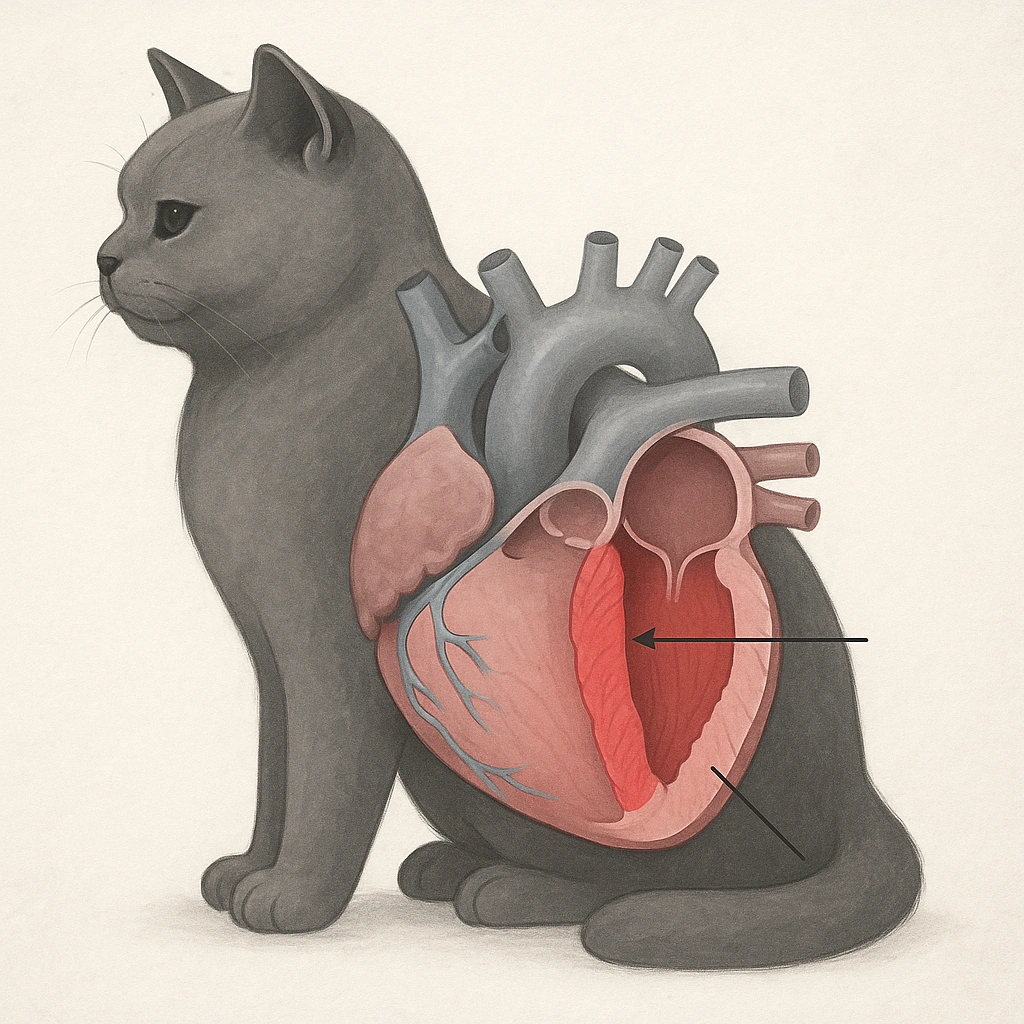
British Shorthair Heart Screening
6. 7 Practical Ways to Support Your British Cat’s Heart
6.1 Weight Control — “Ideal Body Score = 5/9”
Excess fat tissue increases the volume the heart must pump per minute; ventricular wall pressure rises in mmHg terms.
-
Target: Male British Shorthair 4.5–5.5 kg; female 3.5–4.5 kg.
-
Tactic: Use a smart (chip‑based) feeder to prevent portion “sneak‑ins.”
6.2 Low‑Sodium Nutrition — “Look for [%0.3 NaCl] on the Label”
Salt triggers fluid retention and increases the risk of pulmonary edema.
-
Label Reading: “Sodium (as‑fed) < 0.25%” is ideal.
-
Home‑Prepared Diet: Cooked chicken + calcium carbonate; do not add sodium.
6.3 Taurine & L‑Carnitine Supplementation — “The Power Plant”
They play essential roles in myocardial ATP synthesis; deficiency can mimic the HCM phenotype.
-
Dose: Taurine 250 mg/kg; L‑carnitine 50 mg/kg, in two divided doses daily.
-
Monitoring: Serum level every 3 months, target > 60 µmol/L.
6.4 Avoid Indoor Stress — “Calm Environment”
Adrenaline raises heart rate and skyrockets myocardial oxygen consumption.
-
Quiet Room: Isolate from washing machine and vacuum cleaner noise.
-
Vertical Space: Shelf‑tunnel combo; British Shorthairs like to observe from heights, stress hormones drop.
6.5 Regular but Measured Exercise — “The 8‑Minute Rule”
Short, high‑intensity indoor play; avoid long chases.
-
Plan: 3 × 8 minutes with a wand toy + 2 minutes rest.
-
Practice: Jump height < 60 cm; < 40 cm in obstructive cases.
6.6 Vaccination & Parasite Control — “Infection = Myocarditis Risk”
Mycoplasma haemofelis and heartworm can cause myocardial inflammation and worsen the HCM course.
-
Vaccine Schedule: Core FVRCP (Combo) and Rabies + annual boosters, with veterinary cardiology approval.
-
Spot‑on Program: Rotate selamectin / fluralaner every 30 days.
6.7 Don’t Postpone the Annual Check‑up
Critical Note: These seven steps don’t eliminate genetic predisposition; however, they reduce clinical complications of HCM by over 50%.
7. Advantages for Your British Cat at Zoom Veterinary Clinic
British Shorthair heart screening at our Erenköy Zoom Veterinary Clinic guarantees your cat’s comfort as much as diagnostic accuracy. Here are five highlights of our truly “cat‑friendly” cardiology service:
| Advantage | Detailed Description | Effect for Your Cat |
|---|---|---|
| Central Location (Kadıköy Erenköy) | Public transport + parking convenience on Istanbul’s Anatolian side. | Travel stress down by 25% (shorter transport time). |
| Cat‑Friendly Waiting & Exam Room | Area separated from noise and dog traffic, with synthetic pheromone diffusers. | Cortisol −40%; blood pressure readings more realistic. |
| Specialist Cardiology Equipment | High‑resolution Wisonic Piloter Vet echocardiography | Left atrial diameter and SAM angle measured with ±0.1 mm precision; lower false‑positive rate. |
| Holistic Approach | Protocol integrating nutrition, phytotherapy (L‑carnitine, omega‑3), and stress management into treatment. | Because medication + diet + supplements are synchronized, quality of life improves long term. |
| 24‑Hour Emergency Support & ICU | Oxygen, heated intensive care, and continuous ECG monitoring for sudden thromboembolism or acute pulmonary edema. | Survival odds in a crisis are tripled. |
Additional note: If you repeat annual check‑ups at the same clinic, previous echocardiography measurements are added to the report for comparison; we track progression down to millimeters. British Shorthair Heart Screening
8. Who Should Be Prioritized for Cardiology Screening?
Considering the genetic risk in the British Shorthair breed, the five groups below fall into the “high priority” category for British Shorthair heart screening:
-
Breed and Color Variety
-
All British Shorthair cats—regardless of blue, lilac, or golden shaded—are at risk for HCM. Pedigree color variation does not affect mutation prevalence.
-
Males and Cats Aged 2–4 Years
-
Statistics show HCM prevalence rises to 20% in males and up to 8% in females. First clinical signs usually begin between 2 and 4 years.
-
Cats Showing Sudden Fatigue, Cough, or Lethargy
-
Even “minor” cues like struggling with stairs or panting after short play may be early signs of left‑sided heart failure.
-
Positive Family History
-
If the same line includes a parent or sibling diagnosed with HCM, risk increases three‑fold. Genetic counseling and twice‑yearly screening are recommended.
-
Cats with a Heart Murmur or Irregular Pulse
-
Hearing a murmur on auscultation does not always mean HCM; however, it can herald the obstructive variant. Echo‑Doppler screening is required.
| Priority Group | Suggested Screening Frequency | Note |
|---|---|---|
| Breed factor only | Annual echo + NT‑proBNP | Even if asymptomatic. |
| Male, 2–4 Years | Once a year | Risk peaks during this transition period. |
| Showing clinical signs | Every 3–6 months | Prognosis monitoring. |
| Positive family history | Every 6 months | Critical for eliminating gene carriers. |
| Murmur/arrhythmia detected | Every 3 months or 4–6 weeks post‑treatment | Medication titration. |
Quick reminder: If you fall into a priority group, it’s recommended to schedule your appointment within one week. Early diagnosis helps prevent 80% of thromboembolic emergencies.
Frequently Asked Questions About British Shorthair Heart Screening
Which is the most recent study reporting HCM rates in British Shorthairs?
A 2021 prospective screening in Denmark published in the Journal of Feline Medicine & Surgery reported 8.5% definitive and 4.3% “suspicious” HCM findings in 329 British Shorthairs. The rate in domestic cats in the comparison group was ≈ 3%; this difference strengthens the recommendation for annual British Shorthair heart screening. British Shorthair Heart Screening
How does a closed pedigree (genetically narrow pool) increase heart‑disease risk?
Repeated inbreeding to preserve popular colors reinforces HCM mutations such as MYBPC3. The “bottleneck” effect narrows the gene pool, lowers the threshold for thromboembolism, and increases clotting tendency in the breed.
Why is HCM 2.5× more frequent in male British Shorthairs than in females?
In males, testosterone → IGF‑1 → mTOR pathway activation accelerates myocardial protein synthesis and wall thickening. Also, because males have greater average body mass, ventricular wall tension increases.
How do “delayed symptoms” postpone diagnosis?
British Shorthairs are naturally calm and enjoy short bouts of play. Mild shortness of breath, easy fatigability, or poor appetite is often attributed to a “lazy character” or obesity. Therefore, having a British Shorthair heart screening before symptoms appear is vital.
By what pathophysiologic mechanism does thickened myocardium impair diastole?
With hypertrophy, myocardial fibers shorten and stiffen; the ventricle cannot relax, and filling pressure rises. The increased pressure causes fluid leakage in pulmonary capillaries and leads to pulmonary edema.
How does left atrial enlargement trigger clot formation?
When atrial diameter exceeds 16 mm, blood turbulence decreases and stasis increases. Platelet activation begins on the endothelial surface; the resulting clot usually lodges at the aortic bifurcation, causing hind‑leg paralysis.
What is the SAM phenomenon in obstructive HCM and how is it measured on ultrasound?
Systolic Anterior Motion; during systole, the mitral leaflet strikes the left ventricular outflow tract. On color Doppler, LVOT flow velocity > 3 m/s and end‑systolic turbulence are observed.
How does the MYBPC3 mutation change prognosis? British Shorthair heart screening
In mutation‑positive cats, HCM starts 2 years earlier and annual wall thickening speed is ≈ 0.4 mm (normal: 0.1–0.2 mm). If treatment starts late, average lifespan shortens by 3–4 years.
By how much do early diagnosis and prevention lower the risk of sudden paralysis and death?
With annual British Shorthair heart screening, thromboembolic attacks and malignant arrhythmias can be prevented by 70%; this directly improves quality of life.
What is the threshold for starting L‑carnitine after screening?
When left ventricular wall ≥ 6 mm or NT‑proBNP > 900 pmol/L, 50 mg/kg/day L‑carnitine is recommended to support energy metabolism.
Which two decisions does genetic counseling determine?
(1) Excluding HCM‑positive or carrier cats from breeding, (2) pairing heterozygous cats with low‑risk lines. Thus, disease prevalence decreases over 3–4 generations.
By how much can regular screening reduce veterinary expenses?
Fewer ICU‑level crises reduce total long‑term costs by up to 60%; insurance premiums also drop by around 10%.
By what percentage do pheromone diffusers reduce stress cortisol?
Clinical observations show pheromone support reduces peak cortisol by 40% and improves systolic blood pressure readings by about ±5 mmHg.
What can femoral–radial pulse mismatch indicate?
In atrial fibrillation or ventricular premature beats, peripheral pulse beats may “drop out.” During British Shorthair heart screening, this “pulse deficit” enables early diagnosis.
What is the NT‑proBNP test time and which two conditions increase positivity? British Shorthair heart screening
Results appear in 10 minutes. It is positive in preclinical/clinical HCM and congestive heart failure (> 900 pmol/L).
What is the correct order to avoid white‑coat hypertension error?
First, 5 minutes in the cat‑friendly waiting area, then blood pressure measurement; echo and blood tests last.
Why does HCM peak at ages 1–3?
Growth hormone and androgens peak, activating hypertrophy genes in genetically predisposed myocytes; hence early echo is life‑saving.
What is the wall‑thickening rate at ages 4–7?
Longitudinal studies report an average 0.3 mm/year; in untreated cases this can rise to 0.5 mm/year.
Ideal time and reason for postpartum echocardiography?
4–6 weeks after birth; post‑pregnancy hemodynamic load and plasma volume return to normal, preventing masked measurements.
Why is the screening interval 3–6 months if obstructive HCM is suspected?
SAM angle and LVOT pressure gradient can change within as little as 90 days; early intervention prevents ventricular fibrosis.
What is the ideal male weight range?
4.5–5.5 kg. Every extra 0.5 kg increases cardiac output by 5% and raises wall stress.
What should be the low‑sodium limit?
For dry food, ≤ 0.3% NaCl (as‑fed); < 0.25% is preferred for cardiac diets.
Which cardiomyopathy does taurine deficiency mimic, and what is the target serum level?
Dilated cardiomyopathy; target ≥ 60 µmol/L. Deficiency can reduce ejection fraction by up to 10%.
What is the “8‑Minute Rule”? British Shorthair heart screening
Three 8‑minute moderate‑intensity wand‑toy play sessions daily; in obstructive HCM, keep jump height < 40 cm.
By how many mmHg does noise isolation reduce BP error? British Shorthair heart screening
The “fear increase” added to systole drops by 10–15 mmHg, narrowing the measurement confidence interval.
How do omega‑3 supplements provide antiarrhythmic effects?
EPA/DHA integrate into cell membranes, dampening excessive stimulation of voltage‑gated sodium and calcium channels and reducing prostaglandin E2 production.
How does continuous ECG monitoring change post‑crisis prognosis?
24‑hour intensive care with continuous ECG increases survival after an acute thromboembolic event by threefold.
Male vs female HCM prevalence difference?
Males ≈ 20%, females ≈ 8% — a 2.5× difference, hence males are labeled “high risk.”
Why are cats with positive family history screened every 6 months?
Even when heterozygous, progression accelerates; a 6‑month interval increases the chance of catching the subclinical phase from 40% to 75%.
Within how many days should a “priority group” cat be examined?
Within 7 days at the latest, book a British Shorthair heart screening appointment; delays exponentially increase clot risk.
If I skip British Shorthair heart screening, how much silent progression can occur in a year?
When thickening gets out of control, the left ventricular wall can grow by up to 0.5 mm per year; at your next British Shorthair heart screening, the ventricular diameter may have crossed a critical threshold.
Is it true that no sedation is needed during echocardiography?
Yes. In our British Shorthair heart screening protocol, cat‑friendly handling and quick probe placement eliminate the need for sedation; this also ensures results are closer to physiological (drug‑free) values.
What is the diagnostic accuracy when NT‑proBNP and echocardiography are performed together?
Combining both methods detects subclinical HCM with 85–90% reliability; this package is usually completed in a single British Shorthair heart screening session.
Spaying Female Cats: The Right Time and MethodEven if results are clear, why should I return in 12 months?
British Shorthair genetics mean HCM can become apparent “overnight.” With annual British Shorthair heart screening , we detect millimetric changes and start treatment at the earliest stage. British Shorthair heart screening 2025


